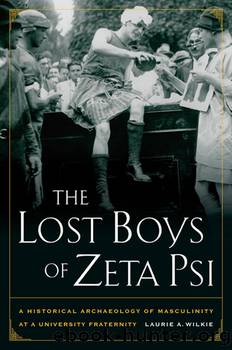The Lost Boys of Zeta Psi: A Historical Archaeology of Masculinity at a University Fraternity by Laurie A. Wilkie

Author:Laurie A. Wilkie [Wilkie, Laurie A.]
Language: eng
Format: epub
ISBN: 978-0-520-94594-4
Publisher: University of California Press
Published: 2010-08-15T00:00:00+00:00
RITUAL LIFE OF FRATERNITIES
In the remains of the first house, we found little evidence of the ritual life that surely must have been part of the fraternity experience. We know that ritualâboth as a means of initiation and as an expression of membershipâplayed some role in the fraternity. There is mention of the pledge pin, an outward symbol of oneâs affiliation (figure 22). The Zetes themselves referred to the importance of ritual to affirming the bond between brothers. Zeta Psi, as a fraternity founded by Masons, borrowed heavily from that source in its rituals. Zeta Psi was described in 1899 as âimpressing upon its members, rather more than some like organizations, the importance of profound secrecy regarding the society and its affairs.â11
An examination of the available evidence leaves the nature of the rituals largely invisible to us, but it is possible to make some generalizations. P. F. Piper, a late-nineteenth-century essayist, provides a general overview of fraternity ritual at that time. He observes that, in general, there was much overlap in the specific rituals of the various organizationsâlargely because the different organizations had taken to stealing from one another. The use of initials that represented a motto and which gave the fraternity its name, and the system of signs, grips, passwords, sets of colors, flower, and crest, characterized all the organizations.12 Piper also describes a typical hazing ritual: âThere is usually a preliminary ordeal, during which the neophyte is obliged to submit to many ridiculous indignities. During this time he is required to obey all orders given by any member of the chapter to which he is pledged. Thus it happens that often a candidate may be seen rolling a peanut along a street, using a toothpick as a lever, others sell newspapers, black boots, or wheel baby carriages.â13
Piper acknowledges that more dangerous feats were not unknown, and refers to the death of a man at Cornell and one at Yale, which had occurred just a few years earlier. At Cornell, a young man who was blindfolded and led to the edge of a gorge disobeyed the order of his brothers and stepped forward, causing all three to fall to the bottom of one of Ithacaâs infamous gorges. The young man died of his injuries, but not before exonerating his companions. In the Yale case, a blindfolded man was led to an alley, where in the dark he collided with a wagon and died from his injuries. The author seemed to think that these two incidents had done much to curtail more dangerous initiation rituals among students.14
Download
This site does not store any files on its server. We only index and link to content provided by other sites. Please contact the content providers to delete copyright contents if any and email us, we'll remove relevant links or contents immediately.
Macmillan Primary Grammar 2 Pupil's Book by Unknown(409)
Figuring Out Fluency in Mathematics Teaching and Learning, Grades K-8 by Jennifer M. Bay-Williams & John J. SanGiovanni(370)
The Principal's Guide to Curriculum Leadership by Sorenson Richard D.;Goldsmith Lloyd M.;Mendez Zulma Y.;Maxwell Karen T.;(292)
Learning from Accidents 3rd ed by Trevor Kletz (2001)(255)
English Grammar Practice--The Noun by Roxana Nastase(253)
Harnessing Technology for Deeper Learning by Scott McLeod(246)
Text-Dependent Questions, Grades K-5 by Douglas Fisher & Nancy Frey & Heather Anderson & Marisol Thayre(231)
A Guide to Curriculum Mapping by Hale Janet A.;(227)
English Language Program Administration by Unknown(218)
How to Do Everything with Google Tools by Unknown(216)
Deep Change Leadership by Reeves Douglas;(208)
The Grammar Teacher's Activity-a-Day by Jack Umstatter(202)
The Power of SMART Goals by Conzemius Anne;O'Neill Jan; & Anne Conzemius(193)
Beyond the RTI Pyramid by Bender William N.;(175)
Aligning and Balancing the Standards-Based Curriculum by Squires David A.;(172)
Using Data to Close the Achievement Gap by Johnson Ruth S.;(169)
Using Equity Audits to Create Equitable and Excellent Schools by Skrla Linda E.;McKenzie Kathryn B.;Scheurich James Joseph;(167)
Differentiated Instructional Strategies for the Block Schedule by Gregory Gayle H.;Herndon Lynne E.; & Lynne E. Herndon(166)
You've Got to Reach Them to Teach Them by Schreck Mary Kim; & Schreck(158)
